春节来历的绘本故事:熬年守岁和年兽的传说(pdf英文版)
- 格式:pdf
- 大小:2.10 MB
- 文档页数:15
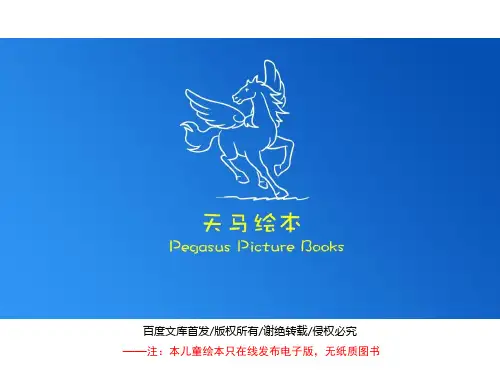
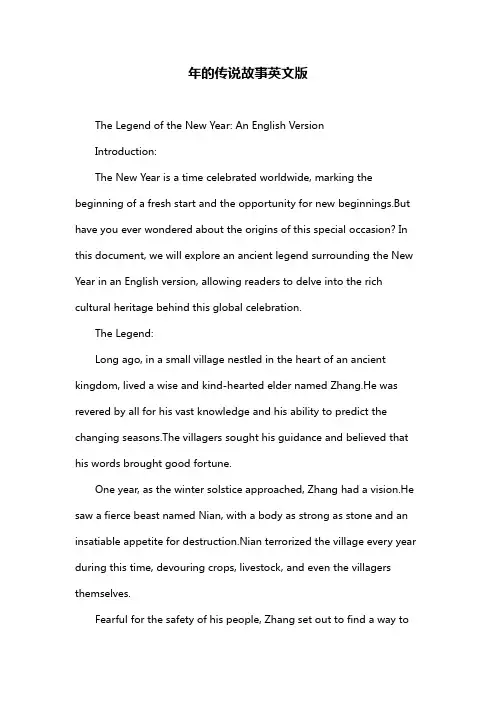
年的传说故事英文版The Legend of the New Year: An English VersionIntroduction:The New Year is a time celebrated worldwide, marking the beginning of a fresh start and the opportunity for new beginnings.But have you ever wondered about the origins of this special occasion? In this document, we will explore an ancient legend surrounding the New Year in an English version, allowing readers to delve into the rich cultural heritage behind this global celebration.The Legend:Long ago, in a small village nestled in the heart of an ancient kingdom, lived a wise and kind-hearted elder named Zhang.He was revered by all for his vast knowledge and his ability to predict the changing seasons.The villagers sought his guidance and believed that his words brought good fortune.One year, as the winter solstice approached, Zhang had a vision.He saw a fierce beast named Nian, with a body as strong as stone and an insatiable appetite for destruction.Nian terrorized the village every year during this time, devouring crops, livestock, and even the villagers themselves.Fearful for the safety of his people, Zhang set out to find a way todefeat Nian.He studied ancient texts and observed the patterns of nature.Finally, he discovered that Nian could be frightened away by loud noises, bright colors, and the boldness of the villagers.With this knowledge, Zhang devised a plan.He instructed the villagers to make loud noises by setting off fireworks and banging drums.They were to decorate their homes with red lanterns and couplets, as red was believed to be a lucky color that would scare away the beast.Additionally, the villagers were advised to gather in groups and wear colorful attire to display their unity and bravery.On the eve of the New Year, the villagers followed Zhang"s instructions.The air filled with the sound of exploding fireworks and the beat of drums.The village shimmered with the glow of red lanterns, and the people wore their brightest clothes, cheering and laughing together.Sure enough, when Nian approached the village, he was overwhelmed by the noise, colors, and the villagers" bravery.Terrified, he turned tail and fled, never to return again.From that day forward, the village celebrated the New Year with great joy and gratitude, adopting the traditions that Zhang had introduced to keep Nian at bay.Conclusion:The legend of Nian and the New Year serves as a reminder of the power of unity, courage, and the celebration of new beginnings.As we welcome the New Year in our modern lives, let us remember thesignificance of this ancient tale and embrace the opportunities it brings for renewal and happiness.。

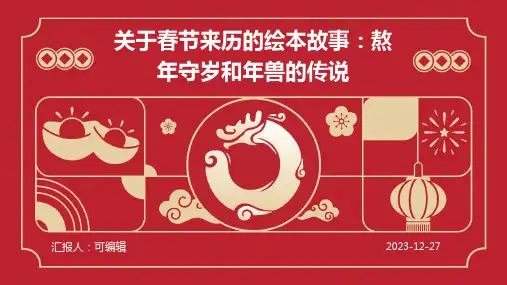
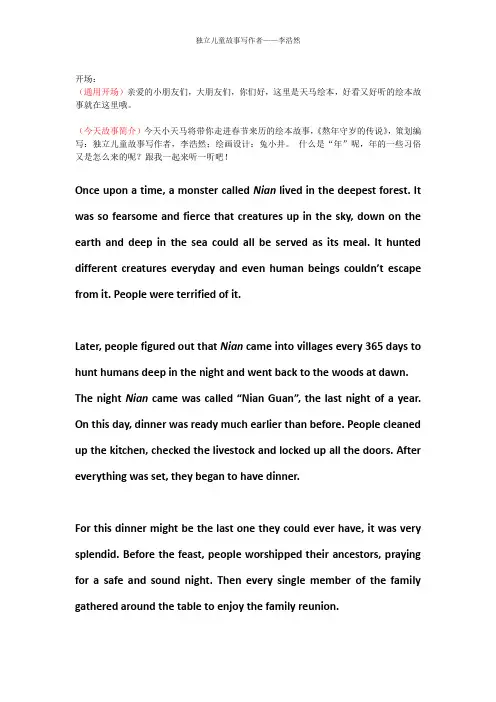
独立儿童故事写作者——李浩然开场:(通用开场)亲爱的小朋友们,大朋友们,你们好,这里是天马绘本,好看又好听的绘本故事就在这里哦。
(今天故事简介)今天小天马将带你走进春节来历的绘本故事,《熬年守岁的传说》,策划编写:独立儿童故事写作者,李浩然;绘画设计:兔小井。
什么是“年”呢,年的一些习俗又是怎么来的呢?跟我一起来听一听吧!Once upon a time, a monster called Nian lived in the deepest forest. It was so fearsome and fierce that creatures up in the sky, down on the earth and deep in the sea could all be served as its meal. It hunted different creatures everyday and even human be ings couldn’t escape from it. People were terrified of it.Later, people figured out that Nian came into villages every 365 days to hunt humans deep in the night and went back to the woods at dawn. The night Nian came was called “Nian Guan”, the last nigh t of a year. On this day, dinner was ready much earlier than before. People cleaned up the kitchen, checked the livestock and locked up all the doors. After everything was set, they began to have dinner.For this dinner might be the last one they could ever have, it was very splendid. Before the feast, people worshipped their ancestors, praying for a safe and sound night. Then every single member of the family gathered around the table to enjoy the family reunion.。
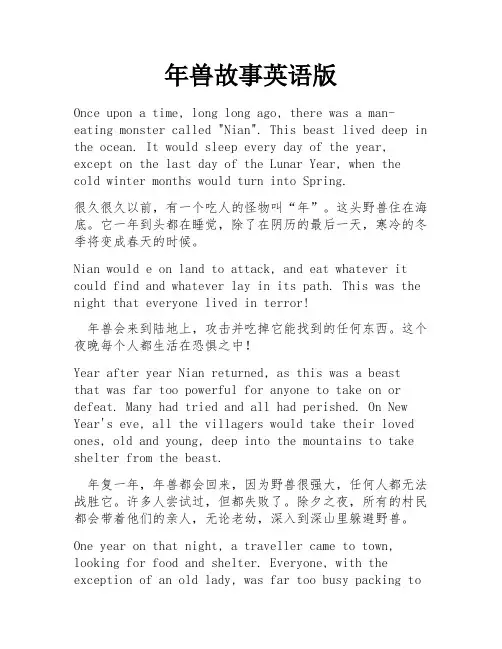
年兽故事英语版Once upon a time, long long ago, there was a man-eating monster called "Nian". This beast lived deep in the ocean. It would sleep every day of the year, except on the last day of the Lunar Year, when the cold winter months would turn into Spring.很久很久以前,有一个吃人的怪物叫“年”。
这头野兽住在海底。
它一年到头都在睡觉,除了在阴历的最后一天,寒冷的冬季将变成春天的时候。
Nian would e on land to attack, and eat whatever it could find and whatever lay in its path. This was the night that everyone lived in terror!年兽会来到陆地上,攻击并吃掉它能找到的任何东西。
这个夜晚每个人都生活在恐惧之中!Year after year Nian returned, as this was a beastthat was far too powerful for anyone to take on or defeat. Many had tried and all had perished. On New Year's eve, all the villagers would take their loved ones, old and young, deep into the mountains to take shelter from the beast.年复一年,年兽都会回来,因为野兽很强大,任何人都无法战胜它。
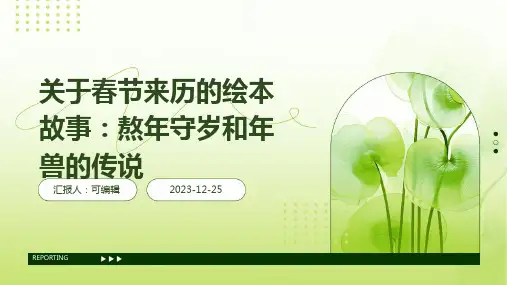
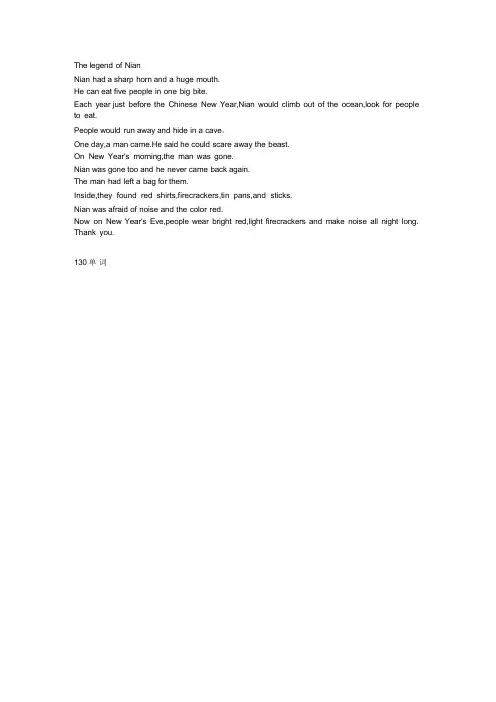
The legend of NianNian had a sharp horn and a huge mouth.He can eat five people in one big bite.Each year just before the Chinese New Year,Nian would climb out of the ocean,look for people to eat.People would run away and hide in a cave。
One day,a man came.He said he could scare away the beast.On New Year's morning,the man was gone.Nian was gone too and he never came back again.The man had left a bag for them.Inside,they found red shirts,firecrackers,tin pans,and sticks.Nian was afraid of noise and the color red.Now on New Year's Eve,people wear bright red,light firecrackers and make noise all night long. Thank you.130 单词年的传说年兽有一个锋利的角和一张大嘴。
它能一口吃掉五个人。
每年春节前,年都会从海洋里爬出来,找人吃。
人们会跑开,躲在山洞里。
一天,一个男人来了。
他说他能把野兽吓跑。
在新年的早晨,那个人走了。
年也走了,再也没有回来。
那人给他们留下了一个袋子。
在里面,他们发现了红衫、鞭炮、锡锅和棍子。
年害怕噪音和红色。
现在在除夕夜,人们穿着大红色的衣服,放鞭炮,整夜大声喧哗。
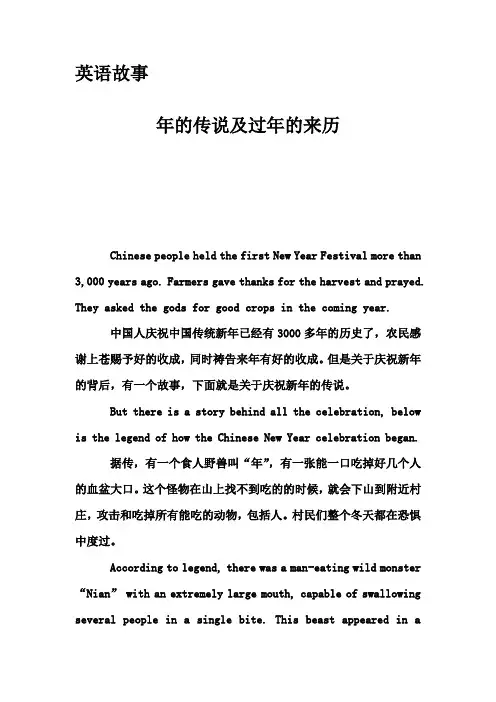
英语故事年的传说及过年的来历Chinese people held the first New Year Festival more than 3,000 years ago. Farmers gave thanks for the harvest and prayed. They asked the gods for good crops in the coming year.中国人庆祝中国传统新年已经有3000多年的历史了,农民感谢上苍赐予好的收成,同时祷告来年有好的收成。
但是关于庆祝新年的背后,有一个故事,下面就是关于庆祝新年的传说。
But there is a story behind all the celebration, below is the legend of how the Chinese New Year celebration began.据传,有一个食人野兽叫“年”,有一张能一口吃掉好几个人的血盆大口。
这个怪物在山上找不到吃的的时候,就会下山到附近村庄,攻击和吃掉所有能吃的动物,包括人。
村民们整个冬天都在恐惧中度过。
According to legend, there was a man-eating wild monster “Nian”with an extremely large mouth, capable of swallowing several people in a single bite. This beast appeared in acountry village, towards the end of winter when there was nothing to eat it would visit the villages and attack and eat whatever it could. The villagers would live in terror over the winter.据传说,有一个人吃的野生怪物“年”一个非常大的口,吞咽几个人在一个单一的叮咬。
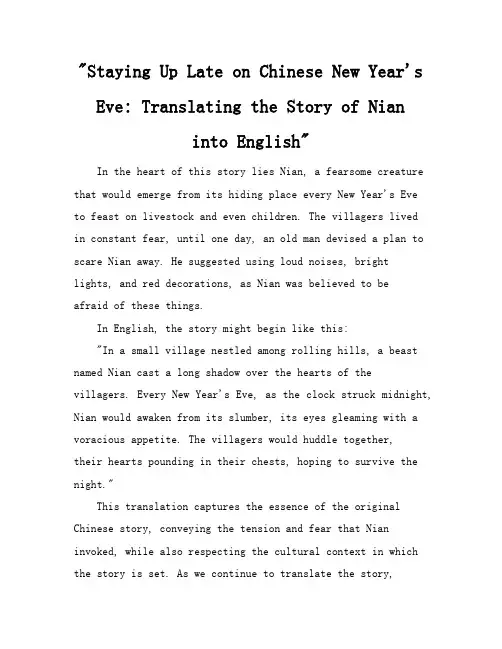
"Staying Up Late on Chinese New Year's Eve: Translating the Story of Nianinto English"In the heart of this story lies Nian, a fearsome creature that would emerge from its hiding place every New Year's Eveto feast on livestock and even children. The villagers livedin constant fear, until one day, an old man devised a plan to scare Nian away. He suggested using loud noises, brightlights, and red decorations, as Nian was believed to beafraid of these things.In English, the story might begin like this:"In a small village nestled among rolling hills, a beast named Nian cast a long shadow over the hearts of thevillagers. Every New Year's Eve, as the clock struck midnight, Nian would awaken from its slumber, its eyes gleaming with a voracious appetite. The villagers would huddle together,their hearts pounding in their chests, hoping to survive the night."This translation captures the essence of the original Chinese story, conveying the tension and fear that Nian invoked, while also respecting the cultural context in which the story is set. As we continue to translate the story,we'll weave in the traditions of staying up late and the eventual triumph of wisdom and bravery over fear."The Legend of Nian: How a Village's Courage Transformed a New Year's Tradition"The tale of Nian unfolds with the villagers discovering the beast's weaknesses. They learn that Nian is terrified of the color red, loud noises, and fire. With this knowledge, the villagers embark on a mission to outsmart the creature and protect their homes.In English, the continuation of the story might read:"Determined to end Nian's reign of terror, the villagers put their faith in the old man's wisdom. They adorned their homes with red lanterns, believing that the vibrant hue would deter the beast. They crafted drums and cymbals, ready to create a cacophony that would send shivers down Nian's spine. And they prepared fireworks, a brilliant display of light and sound to scare Nian away."The night of New Year's Eve arrived, and the village was a sea of red and noise. The translation continues:"As the first shadows of night crept over the village, every man, woman, and child took their place, their resolve as strong as the red lanterns that swayed gently in the breeze. The air was thick with anticipation. When Nianfinally appeared, its eyes widening at the sight of thevillage transformed, the villagers unleashed their assault.""Nian, confronted with the blinding red and the deafening roar, was overwhelmed. It turned tail and fled, never to be seen again. The village erupted in joy, their laughter and cheers mingling with the fading echoes of the drums. Fromthat night on, staying up late on New Year's Eve, or 'shou sui,' became a symbol of the villagers' vigilance and their victory over fear.""The Legacy of Nian: Embracing Tradition in the Englishspeaking World"As the tale of Nian has been shared across generations,it has also crossed oceans, finding its place in the heartsof those who speak English. The story, now a part of global folklore, serves as a bridge between cultures, illustratingthe universal themes of courage and the triumph of good over evil.To further encapsulate the spirit of the story in English, we might add:"The legend of Nian, once confined to the oral traditions of a small Chinese village, has journeyed far and wide. In Englishspeaking countries, it is told with the same fervorand respect, often during cultural exchange programs or in classrooms studying world mythology. The story resonatesbecause it speaks to a fundamental human experience – the battle against the darkness that threatens our peace."In translating the story for an Englishspeaking audience, it's important to highlight the cultural practices that have emerged from the legend:In closing, the translation of the story of Nian into English is more than a linguistic exercise; it's an act of cultural preservation and sharing. It allows the legend to continue its journey, inspiring and enlightening all who hear it, and reminding us that the power of storytelling knows no bounds.。
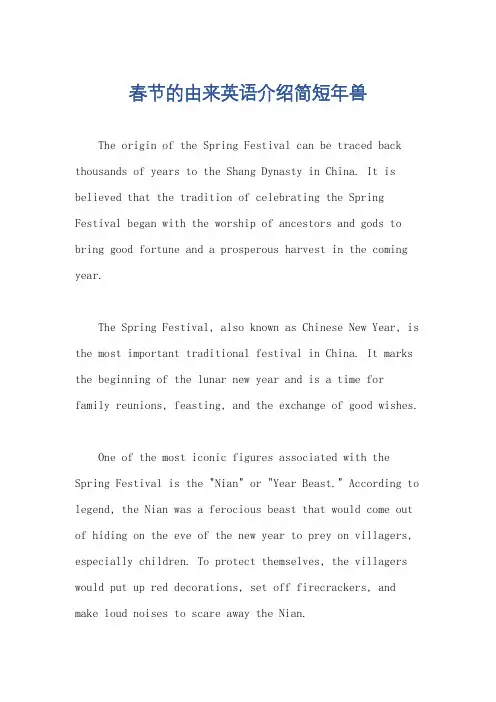
春节的由来英语介绍简短年兽The origin of the Spring Festival can be traced back thousands of years to the Shang Dynasty in China. It is believed that the tradition of celebrating the Spring Festival began with the worship of ancestors and gods to bring good fortune and a prosperous harvest in the coming year.The Spring Festival, also known as Chinese New Year, is the most important traditional festival in China. It marks the beginning of the lunar new year and is a time forfamily reunions, feasting, and the exchange of good wishes.One of the most iconic figures associated with the Spring Festival is the "Nian" or "Year Beast." According to legend, the Nian was a ferocious beast that would come out of hiding on the eve of the new year to prey on villagers, especially children. To protect themselves, the villagers would put up red decorations, set off firecrackers, and make loud noises to scare away the Nian.Over time, the Nian became a symbol of the challenges and obstacles that people face in their lives. Today, the tradition of using firecrackers and wearing red clothing during the Spring Festival is believed to ward off evil spirits and bring good luck for the coming year.In addition to the Nian, other customs and traditions associated with the Spring Festival include the giving and receiving of red envelopes containing money, the preparation and sharing of special foods, and the lighting of fireworks to celebrate the new year.In summary, the Spring Festival is a time-honored tradition in China that is steeped in history and folklore. The Nian, or Year Beast, is a central figure in the mythology of the festival, representing the triumph of good over evil and the hope for a prosperous and auspicious new year.。
关于年的传说英文版简短
Legend of Nian.
In ancient China, there was a terrifying beast called Nian that would come out on the eve of the lunar new year to devour livestock, crops, and even people. The villagers discovered that Nian was afraid of loud noises, bright lights, and the color red. So, they started using firecrackers, lanterns, and red decorations to scare off the beast. From then on, the tradition of celebrating the new year with fireworks, lanterns, and red decorations became a way to ward off Nian and bring good luck for the year ahead.
中文翻译:年兽传说。
在古代中国,有一种可怕的野兽叫做年兽,它会在农历新年前夕出现,吞食牲畜、庄稼,甚至人类。
村民们发现,年兽害怕大声的噪音、明亮的光线和红色。
因此,他们开始使用鞭炮、灯笼和红色装饰来吓走这只野兽。
从那时起,用烟花、灯笼和红色装饰来庆祝新年的传统成为了赶走年兽和带来新一年好运的方式。
春节传说故事版英语作文Long ago in ancient China, there was a legend about a monster called Nian. It was said that Nian would come outon the eve of the lunar new year to terrorize the villagers, eating their livestock and even their children.The villagers were terrified of Nian, until one day, an old man came to their rescue. He told the villagers that Nian was afraid of the color red, loud noises, and bright lights. So the villagers hung red lanterns, set off firecrackers, and stayed up all night making loud noises to scare Nian away.From that day on, the tradition of hanging red lanterns, setting off firecrackers, and staying up all night on the eve of the lunar new year became a way for the villagers to protect themselves from Nian.As time went on, the tradition evolved into what we now know as the Spring Festival, or Chinese New Year. It is atime for families to come together, to eat delicious food, and to wish each other good luck and prosperity for the coming year.Another legend associated with the Spring Festival is the story of the Kitchen God. It is said that the Kitchen God would return to heaven to report on the behavior of each family. To ensure a good report, families would offer the Kitchen God sweet treats and sticky rice cakes to sweeten his words and stick his mouth shut.In modern times, the Spring Festival has become a time for people to travel back to their hometowns to reunite with their families. The tradition of giving red envelopes filled with money to children and unmarried adults has also become a way to share good fortune and blessings.The Spring Festival is a time of joy, celebration, and renewal. It is a time to honor the traditions of the past and to look forward to the promise of the future. And as the legend of Nian reminds us, it is a time to cometogether to overcome our fears and protect each other from harm.。
春节小故事六格漫画英语Title: A Traditional Chinese New Year Story in a Six-Frame Comic StripIntroduction:The Chinese New Year, also known as Spring Festival, is one of the most important traditional holidays in China.It"s a time for family reunions, colorful decorations, and numerous customs and traditions.Below is a six-frame comic strip that tells a heartwarming story about the Chinese New Year, with each frame containing a brief English description.Frame 1:Title: Preparations BeginDescription: A family is bustling around, cleaning their home and putting up red couplets and lanterns.The parents explain to their child that this is all in anticipation of the Spring Festival, symbolizing a fresh start and warding off evil spirits.Frame 2:Title: Reunion DinnerDescription: It"s the evening before the New Year.The whole family gathers around the table, enjoying a feast of dumplings, fish, and other traditional ughter and stories fill the air as they catch up on thepast year.Frame 3:Title: The SpringCouplet ChallengeDescription: The next morning, the family engages in the custom of writing spring couplets.The child, with a brush in hand, tries to come up with a matching phrase for "Happy New Year" written by their father, while the mother watches with delight.Frame 4:Title: The Lion DanceDescription: The family goes out to the town square to watch a vibrant lion dance performance.The child"s eyes widen with excitement as the colorful lions move to the rhythm of drums and cymbals, bringing good luck and fortune to all who watch.Frame 5:Title: Red EnvelopesDescription: Visiting relatives, the child receives red envelopes, or "hongbao," from their elders.The child learns about the significance of giving and receives blessings for health, happiness, and good fortune in the new year.Frame 6:Title: Fireworks and WishesDescription: As the sky darkens on New Year"s Eve, the family lightsfireworks and watches the colorful display.They make wishes upon the stars, hoping for an even more prosperous and joyous year ahead.Conclusion:This six-frame comic strip captures the essence of the Chinese New Year, showcasing the importance of family, traditions, and the hope for a bright future.。
英语简单四格漫画春节故事Spring Festival, also known as the Chinese New Year, is one of the most celebrated traditional festivals in China. It is a time when families gather together, feast on sumptuous food, and exchange red envelopes filled with money.The first panel of the four-paneled comic strip depicts a typical Chinese household preparing for the Spring Festival. The family members are shown shopping for food, cleaning the house, and decorating with all sorts of red ornaments, such as banners, lanterns, and paper cutouts of the zodiac animals.The second panel shows the family members sitting around a table filled with various dishes, such as dumplings, fish, chicken, and rice cakes. They raise their glasses to toast to good health, good fortune, and a happy new year. In the background, fireworks light up the sky, adding to the festive atmosphere.The third panel of the comic strip shows the children of the family eagerly waiting for their Red Envelopes, or "hongbao," from their elders. Traditionally, it is believed that the money inside the red envelopes will bring good luck and blessings to the recipient. The children are thrilled and grateful for the money they receive, which they will use to buy toys or save for future expenses.The final panel of the comic strip shows the family enjoying various activities during the Spring Festival, such as watching the lion and dragon dances, playing games, and visiting relatives and friends. This panel emphasizes the importance of family and community during the Spring Festival.In conclusion, the four-panel comic strip captures the essence of the Spring Festival and highlights the traditions and customs that make this festival so special in Chinese culture. It reminds us of the joy, warmth, and togetherness that the Spring Festival brings to families and communities all over China.。
关于春节的故事传说英文Title: Legends and Myths of the Chinese Spring Festival: An English RetellingIntroduction:The Chinese Spring Festival, also known as the Chinese New Year, is one of the most important traditional holidays in China.It is a time of joy, celebration, and family reunions.Behind this grand festival lie numerous captivating stories and legends that have been passed down through generations.Here, we present some of these fascinating tales in English.1.The Monster Nian:One of the most famous legends surrounding the Spring Festival is the story of the monster Nian.According to ancient Chinese folklore, Nian was a fierce beast that would terrorize villages and devour children during the winter.To protect themselves, villagers would put up red decorations, set off firecrackers, and make loud noises to scare away Nian.This tradition is still practiced today, symbolizing the expulsion of evil spirits and the welcoming of a new year filled with good fortune.2.The God of Wealth:Another popular legend is that of the God of Wealth, also known as Caishen.It is believed that on the fifth day of the New Year, Caishendescends from heaven to bring prosperity and wealth to households.To welcome him, people clean their homes, light incense, and place offerings such as oranges, tangerines, and gold decorations at their altars.This practice is thought to attract good fortune and ensure a prosperous year ahead.3.The Kitchen God:In Chinese tradition, the Kitchen God is a deity who watches over the household and reports the family"s actions to the heavenly emperor.Before the New Year, people would clean their kitchens and offer sacrifices to the Kitchen God, hoping for his favorable report.This legend emphasizes the importance of moral conduct and the belief that good deeds will be rewarded with blessings in the coming year.4.The Lantern Festival:The Lantern Festival, which falls on the 15th day of the first lunar month, marks the end of the Spring Festival celebrations.One of the most well-known stories associated with this festival is that of the heavenly lanterns.Legend has it that a celestial being once descended to earth on the 15th day of the first lunar month, bringing a magical lantern with him.The beauty of the lanterns inspired people to create their own, symbolizing the quest for knowledge and enlightenment.5.The Great Race:According to another legend, the order of the Chinese zodiacanimals was determined by a great race.The animals competed in a swim across a river, and the sequence of their arrival decided their ranking in the zodiac.This story is often retold during the Spring Festival, as each year is associated with a particular animal of the zodiac, and people born in that year are believed to possess the traits of that animal.Conclusion:The Spring Festival is not only a time of celebration but also a treasure trove of rich cultural stories and legends.These tales, filled with moral lessons and symbolism, have been passed down through generations, adding depth and meaning to the festival.By sharing these stories in English, we hope to spread the cultural richness of the Chinese Spring Festival to a wider audience.。
•年兽Once upon a t i me,there was a fe roc i ous m ons ter named"Nian".He ran around, harming people's horses,ca t t l e,sheep,p igs,dogs and ch ickens,and hur t many people.Shennong,the anc ient one, dec i ded to puni sh"Nian"and lock him in the m ounta ins. He was only a l lowed to come out once a year.But when would"Nian"come ou t?People d idn't know,so t hey were a lways af ra id.One day passed,and "Nian"d i d no t come.A month passed,and"Ni an"d id not come.Oh, he was s t i l l so f e roc ious!"Nian"hunted s heep and bi t dogs when he saw one. His eyes were widened,seek ing fo r prey.•U nti l one day, Shennong,the ancient one, held aw hip in his hand, and he lashed the beas t on the backside,and the ferocious "Nian"fel l t o the ground. Nian ran back t o the mountains and never dared to co me out again.Since then,people quick ly ge t ready every twe l f th lunarm onth:they s to re gra in in t he warehouse,put vege tabl e s in big j a r s,dr ive t he i r ch ickens in to the nes t and the i r ca t t l e back to t he ca t t l e pen.Everyone has beco m e fami l ia r with Nian's t emper and found tha t he i s mos t af ra id o f t he co lor red. He i s a l so par t i cu la r l y a f ra id o f f i r e and noise-easy-peasy!At the end of the t welf th lunar month,"Nian"came. He looked to the l e f t:every door had red paper on i t,and t he paper was covered wi th b locks he couldn't r ecognize,which t e r r i f i ed"Nian" a l ot!"Nian"looked to t he r igh t:every household was br ight ly l i t, with lo tus l an te rns,r abb i t l a nte rns and red l an t erns hanging on the doors. Nian was sca red and s ta r t ed to sc ream!No wadays,ce lebra t ing t he Spr ing Fes t iva l i s s t i l l a t rad i t iona l cus tom of Chinese peop l e.Every fami ly has to p r epare a b ig Ne w Year's Eve dinner.M others a re busy in the ki tchen,and ch i ld ren a re play ing in the l iv ing room.Every fami l y wi l l be reuni ted on th i s day and wi l l ce lebra te the New Year happ i ly!•After t he Spri ng Festival,people wil l happi ly welcom e the arr ival of spr i ng!。